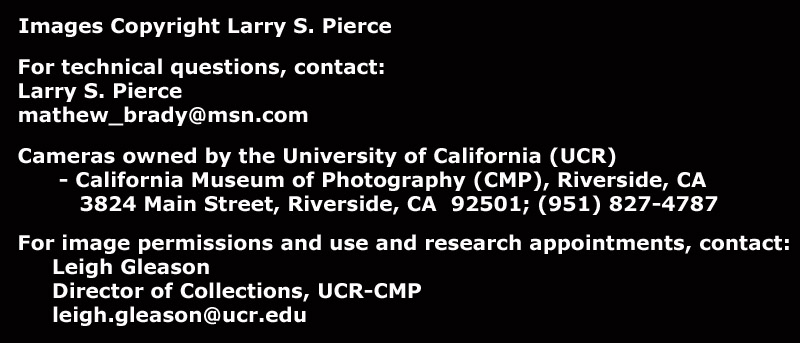Trends in General Construction of Field Cameras
The time 1870-1930 was a period that saw major changes in who purchased and used view cameras, and the construction and features of the cameras reflected the consumer.
The photographic process in 1870 was the wet-plate process. The wet-plate had to be produced immediately prior to exposure, and involved flowing a solution of halide salts in collodion (nitrocellulose) over a glass plate. The collodion contained a mixture of two solvents: ether, which evaporated very rapidly, allowing the film to set so that the plate could be held upright without dripping, and ethanol, which evaporated relatively slowly, to allow the film to stay damp during exposure. In a darkroom, the plate was then placed in a bath of silver nitrate, which reacted with the halide present in the film to create the light-sensitive silver halide salts, after which the plate was placed in the light-tight plate holder of the camera. The still-wet plate was then quickly exposed and developed, since the sensitivity to light was greatly reduced if the plate dried out. The darkroom (which actually could have reddish illumination since the plates were only sensitive to blue light) had to be close to where the exposures took place, so portable tents were devised. The process was cumbersome enough that one didn't dabble into photography on a whim in the 1870's, and, indeed, the vast majority of photographers in the wet-plate era were professionals, usually working in a studio and taking portraits. Some photographers traveled the byways of America, taking portraits from town to town. One can sometimes find the products of their labors: glass negatives bearing stern-looking farmers sitting in a kitchen chair, and around the edges of the plate can be seen the edges and supports of a home-made backdrop - a sheet or blanket strung up between the branches of a tree. So wet-plate field cameras (folding cameras meant to be carried and used outside) are rare not only because they are old, but mainly because there were few photographers using the process.
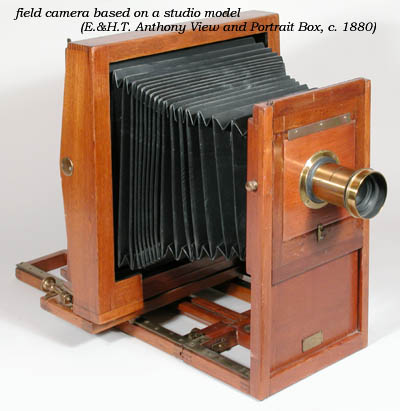 Usually,
wet-plate field cameras were plain and serviceable, as befits their use
by professionals. Often they were robustly made to a fault, being
akin to studio cameras with a folding bed.
Usually,
wet-plate field cameras were plain and serviceable, as befits their use
by professionals. Often they were robustly made to a fault, being
akin to studio cameras with a folding bed.
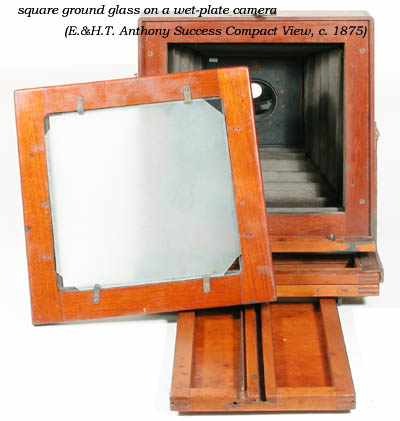 The
ground glass viewing screens of wet-plate field cameras are generally
square. They had to be, since most wet-plate holders had a trough
on the bottom to catch drips, only installed in one direction, and were
designed to hold a plate either horizontally or vertically. The
ground glass therefore needed to be able to view the entire plate in
either direction. Black collodion stains are the hallmark of most
wet-plate cameras, as drips and runs were almost unavoidable, as can be
seen on the example to the right.
The
ground glass viewing screens of wet-plate field cameras are generally
square. They had to be, since most wet-plate holders had a trough
on the bottom to catch drips, only installed in one direction, and were
designed to hold a plate either horizontally or vertically. The
ground glass therefore needed to be able to view the entire plate in
either direction. Black collodion stains are the hallmark of most
wet-plate cameras, as drips and runs were almost unavoidable, as can be
seen on the example to the right.
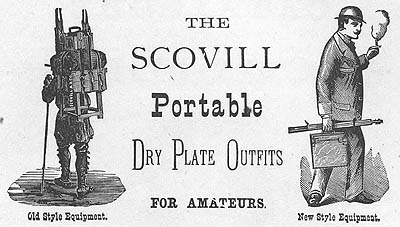 About
1880, the dry-plate was introduced to America. Through careful
ageing, the light-sensitivity of a photographic emulsion could be
maintained even when dry. This development was of great
significance to field photography, since the darkroom could be left at
home, and just the plates carried into the field. Photography was
now available to the amateur (albeit still a determined amateur, since a
field camera does not exactly take snapshots). By 1882-1883, the
established manufacturers like E.&H.T. Anthony and Scovill Mfg. Co. (and
their American Optical) saw a huge upswing in cameras sold. New
manufacturers that would become large, like Rochester Optical Co., and a
host of smaller manufacturers opened their doors on the basis of the new
demand by amateurs.
About
1880, the dry-plate was introduced to America. Through careful
ageing, the light-sensitivity of a photographic emulsion could be
maintained even when dry. This development was of great
significance to field photography, since the darkroom could be left at
home, and just the plates carried into the field. Photography was
now available to the amateur (albeit still a determined amateur, since a
field camera does not exactly take snapshots). By 1882-1883, the
established manufacturers like E.&H.T. Anthony and Scovill Mfg. Co. (and
their American Optical) saw a huge upswing in cameras sold. New
manufacturers that would become large, like Rochester Optical Co., and a
host of smaller manufacturers opened their doors on the basis of the new
demand by amateurs.
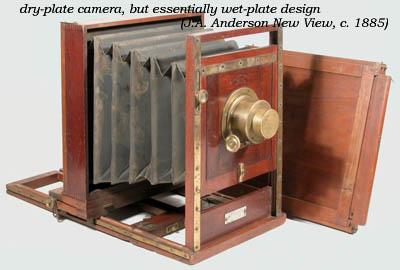 Some
cameras made for dry plates continued to be made based on wet-plate
designs. The example to the right has the classic square ground
glass (not visible) and its studio-like holder that only installs one
way. Bulky and heavy designs like this that served the
professional well did not appeal to the amateur who wanted to travel
light. Their days were numbered.
Some
cameras made for dry plates continued to be made based on wet-plate
designs. The example to the right has the classic square ground
glass (not visible) and its studio-like holder that only installs one
way. Bulky and heavy designs like this that served the
professional well did not appeal to the amateur who wanted to travel
light. Their days were numbered.
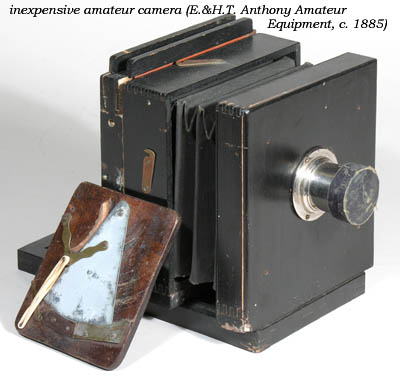 Many
of the camera catalogs of the wet plate era and early dry plate era
described the various cameras offered in words only and in a rather
general way - so general that we are left to guess what the camera so
described would look like, other than it possessed a folding bed, and
lightly yet sturdily built.
Many
of the camera catalogs of the wet plate era and early dry plate era
described the various cameras offered in words only and in a rather
general way - so general that we are left to guess what the camera so
described would look like, other than it possessed a folding bed, and
lightly yet sturdily built.
Many of the earliest offerings were back focus with solid fronts and straight-sided or square bellows.
The same basic design was used for the least expensive models, such as the Anthony Amateur Equipment example to a finely finished and expensive model, such as the American Optical Model 76 example, and everything in between..
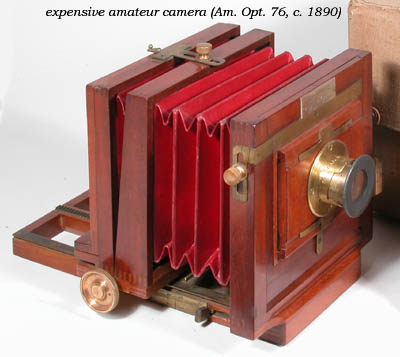
Back focus cameras are generally easier to use than front focus cameras, since the perspective of the subject does not change as the camera is focused.
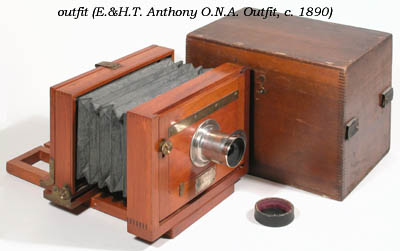 The
period 1885-1895 was one of unprecedented invention of varying designs
of view cameras, all calculated to catch the eye of a discerning
amateur. The customers of this period were treated to large
catalogs profusely illustrated with engravings. Often a camera was
shown from the front, the back and folded. Outfits were
sold, which contained camera, lens, plateholders, dark-cloth, tripod,
and a case or cases to carry it all.
The
period 1885-1895 was one of unprecedented invention of varying designs
of view cameras, all calculated to catch the eye of a discerning
amateur. The customers of this period were treated to large
catalogs profusely illustrated with engravings. Often a camera was
shown from the front, the back and folded. Outfits were
sold, which contained camera, lens, plateholders, dark-cloth, tripod,
and a case or cases to carry it all.
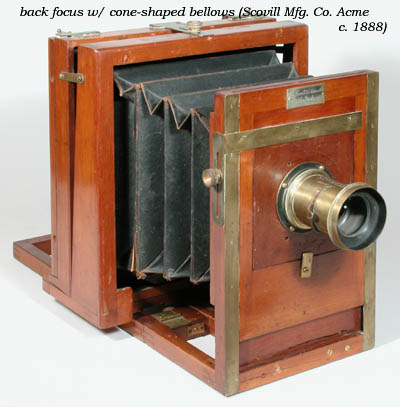 Back
focus cameras were also made having cone-shaped bellows. In fact,
one name that the camera at the right went by was the Back Focus Cone
View. Cone bellows allow the back standard to fit around the front
standard, and therefore fold up more compactly than the square bellows
design.
Back
focus cameras were also made having cone-shaped bellows. In fact,
one name that the camera at the right went by was the Back Focus Cone
View. Cone bellows allow the back standard to fit around the front
standard, and therefore fold up more compactly than the square bellows
design.
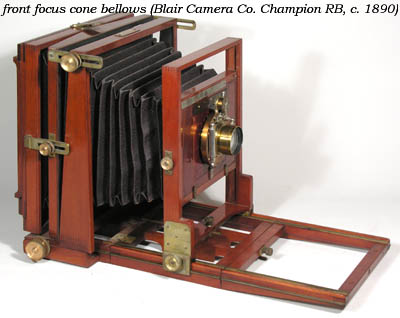 Cone
bellows also appear on front focus cameras.
Cone
bellows also appear on front focus cameras.
Unlike today, in the 1880's camera designs were new enough that patents were used extensively. As a result, camera manufacturers of the era sometimes had to use cumbersome or odd devices to get around a rival's patent. One of the most hotly contested design issues was how to use plates horizontally and vertically. Described above was the wet-plate approach of positioning just the glass plate either way inside of a large holder on a large camera. Since dry plate holders were thin enough to be held by springs, pegs or brads, a new design was needed.
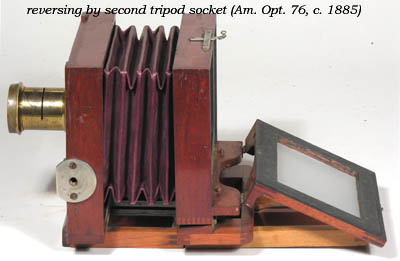 One
obvious was was simply to reposition the entire camera. This
approach was used on many of the small, back focus, square bellows
cameras throughout their period of manufacture. It merely involved
adding a second tripod socket. This design apparently was not
patentable, being used by many manufacturers.
One
obvious was was simply to reposition the entire camera. This
approach was used on many of the small, back focus, square bellows
cameras throughout their period of manufacture. It merely involved
adding a second tripod socket. This design apparently was not
patentable, being used by many manufacturers.
An alternative was Scovill's Lightning Reverser, a tripod accessory that could swivel 90°.
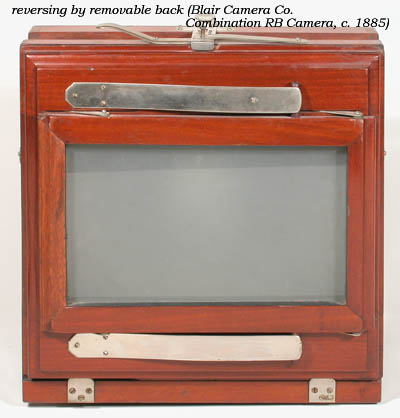 Another
simple approach was to have a square back which could be removed,
rotated 90°, then re-installed. The
Blair companies used this approach throughout, but produced rather large
cameras as a result. In fact, many of their 6.5x8.5" backs will
interchange with the back from a 5x8" camera.
Another
simple approach was to have a square back which could be removed,
rotated 90°, then re-installed. The
Blair companies used this approach throughout, but produced rather large
cameras as a result. In fact, many of their 6.5x8.5" backs will
interchange with the back from a 5x8" camera.
Blair
combated the "large camera" reputation somewhat by producing
extensions, wood or bellowed accessories that would allow, for
instance, an 8x10" camera to take 10x12" images.
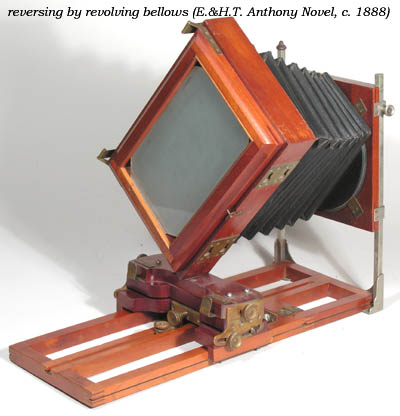 In
an attempt to produce a camera that was light (i.e., not square) and yet
reversible, E.&H.T. Anthony developed a design in which the rear of the
camera is held in place by keybolts. To reverse, the
keybolts are disengaged, and the camera back and bellows is revolved to
a new position. This design was patented on Mar. 2, 1882, and
formed the basis for the Novel, the Klauber, the many types of
Novelettes, the Fairy, and the Phantom Views. The photo at the
right has been taken during rotation, showing the keybolts and keyholes.
In
an attempt to produce a camera that was light (i.e., not square) and yet
reversible, E.&H.T. Anthony developed a design in which the rear of the
camera is held in place by keybolts. To reverse, the
keybolts are disengaged, and the camera back and bellows is revolved to
a new position. This design was patented on Mar. 2, 1882, and
formed the basis for the Novel, the Klauber, the many types of
Novelettes, the Fairy, and the Phantom Views. The photo at the
right has been taken during rotation, showing the keybolts and keyholes.
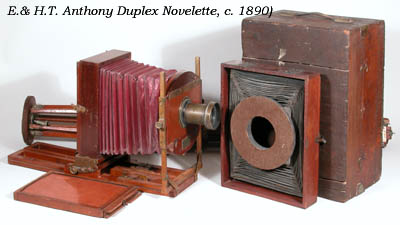 Since
the bellows are necessarily held on a piece of wood separate from the
front standard, one obvious twist is to make the bellows rapidly
removable, at which point the entire back is free. This is the
idea behind the Duplex Novelette, which featured two different sized
back ends (e.g., 5x8 and 8x10) that fit the same track.
Since
the bellows are necessarily held on a piece of wood separate from the
front standard, one obvious twist is to make the bellows rapidly
removable, at which point the entire back is free. This is the
idea behind the Duplex Novelette, which featured two different sized
back ends (e.g., 5x8 and 8x10) that fit the same track.
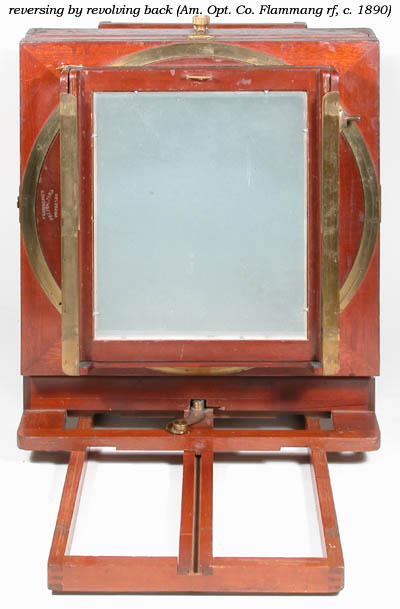 As
if in response, Scovill Mfg. Co. developed a design where the back
stayed on the camera, but revolved along a brass, circular track.
Spring-loaded stops marked the exact horizontal and vertical. It
was granted a patent on Aug. 21, 1883, and is always marked as
Flammang's, since Flammang was the inventor. Unfortunately,
this leads back to the large camera syndrome, as the rotating mechanism
adds several inches to the size. The photo at the right really
doesn't convey the scale of this 11x14" version of one of these.
The Flammang Revolving Back Camera was made by the American Optical
factory, were either front focus or back focus, and were always had the
very highest quality workmanship.
As
if in response, Scovill Mfg. Co. developed a design where the back
stayed on the camera, but revolved along a brass, circular track.
Spring-loaded stops marked the exact horizontal and vertical. It
was granted a patent on Aug. 21, 1883, and is always marked as
Flammang's, since Flammang was the inventor. Unfortunately,
this leads back to the large camera syndrome, as the rotating mechanism
adds several inches to the size. The photo at the right really
doesn't convey the scale of this 11x14" version of one of these.
The Flammang Revolving Back Camera was made by the American Optical
factory, were either front focus or back focus, and were always had the
very highest quality workmanship.
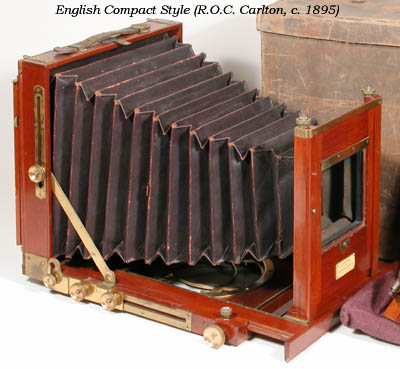 A
design of camera generally referred to as the English Compact Style
were quite popular in England, and versions began to be produced by
American manufacturers in the lat 1880's. The style was extremely
compact, sometimes folding to less than 3" thick. In fact, it
seems it was a little too compact, as the lenses of the day seldom were
able to fit into the camera as folded. Consequently, many English
Compacts are found without their original lens boards and lenses, which
have been become separated from the camera over time. While most
manufacturers were content in producing one model of English Compact
Style, Rochester Optical Co. produced a series: Kenwood,
Monitor, Universal and Carlton, in turn having better
features and finish than the last. Eventually, all these models
were discontinued in favor of The Premo View, which was
manufactured well into the 20th century. More recent cameras, such
as some Deardorff cameras and modern non-monorail view cameras, follow
this same basic pattern.
A
design of camera generally referred to as the English Compact Style
were quite popular in England, and versions began to be produced by
American manufacturers in the lat 1880's. The style was extremely
compact, sometimes folding to less than 3" thick. In fact, it
seems it was a little too compact, as the lenses of the day seldom were
able to fit into the camera as folded. Consequently, many English
Compacts are found without their original lens boards and lenses, which
have been become separated from the camera over time. While most
manufacturers were content in producing one model of English Compact
Style, Rochester Optical Co. produced a series: Kenwood,
Monitor, Universal and Carlton, in turn having better
features and finish than the last. Eventually, all these models
were discontinued in favor of The Premo View, which was
manufactured well into the 20th century. More recent cameras, such
as some Deardorff cameras and modern non-monorail view cameras, follow
this same basic pattern.
 In
the mid-1880's, several models were made which focused either from the
front or back. The Scovill Ripley and Manifold
cameras, the Anthony Clifton, and the Gennert Brighton are
examples. These early examples appear to be cobbled-together
combinations of other models, having one type of front focus (usually
rack and pinion) and a completely different type of back focus (usually
push-pull tightened by a lever).
In
the mid-1880's, several models were made which focused either from the
front or back. The Scovill Ripley and Manifold
cameras, the Anthony Clifton, and the Gennert Brighton are
examples. These early examples appear to be cobbled-together
combinations of other models, having one type of front focus (usually
rack and pinion) and a completely different type of back focus (usually
push-pull tightened by a lever).
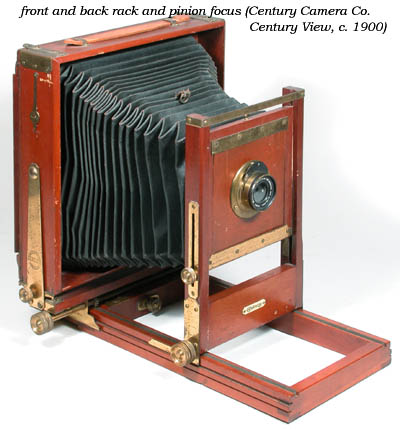 In
1900, the Century Camera Co. was founded. Their very first model
of view camera featured the improvement of using the same rack and
pinion gears for both front and back focus, in which the front and back
standards reside in their own grooves in the side of the rails.
This seemingly obvious development seems to have caused the extinction
of the variety of view camera designs still being made in 1900.
Other factors in the disappearance of view camera variety may have
been the merger of E.&.H.T. Anthony and Scovill Mfg. Co. in 1901, the
purchase of the Blair Camera Co. by E.K.C. in 1899, and the merger of
several Rochester, N.Y. companies including the successors of Rochester
Optical Co. and G. Gennert also in 1899. In 1900, there were fewer
manufacturers and Century had showed them the future. Old modes
such as the Empire State and the Rochester View were soon
altered to match the Century design.
In
1900, the Century Camera Co. was founded. Their very first model
of view camera featured the improvement of using the same rack and
pinion gears for both front and back focus, in which the front and back
standards reside in their own grooves in the side of the rails.
This seemingly obvious development seems to have caused the extinction
of the variety of view camera designs still being made in 1900.
Other factors in the disappearance of view camera variety may have
been the merger of E.&.H.T. Anthony and Scovill Mfg. Co. in 1901, the
purchase of the Blair Camera Co. by E.K.C. in 1899, and the merger of
several Rochester, N.Y. companies including the successors of Rochester
Optical Co. and G. Gennert also in 1899. In 1900, there were fewer
manufacturers and Century had showed them the future. Old modes
such as the Empire State and the Rochester View were soon
altered to match the Century design.
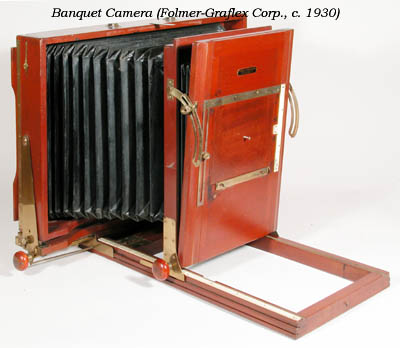 With
the dawn of the new century, the amateur view camera photographer, once
common enough in the 1880's and 1890's to form large photography clubs
in every large city, became extinct. Glass plate view cameras died
out like ungainly dinosaurs, and sheet film-using leather-covered
folding cameras proliferated. The Century Camera Co. and the
re-organized Rochester Optical Co. produced dozens of models, each
having slightly different accoutrements and lenses. View cameras
were once again the tools of the professional, and the only innovative
camera models introduced in the 20th century were strictly for the
professional: the panoramic camera, the skyscraper camera, the banquet
camera.
With
the dawn of the new century, the amateur view camera photographer, once
common enough in the 1880's and 1890's to form large photography clubs
in every large city, became extinct. Glass plate view cameras died
out like ungainly dinosaurs, and sheet film-using leather-covered
folding cameras proliferated. The Century Camera Co. and the
re-organized Rochester Optical Co. produced dozens of models, each
having slightly different accoutrements and lenses. View cameras
were once again the tools of the professional, and the only innovative
camera models introduced in the 20th century were strictly for the
professional: the panoramic camera, the skyscraper camera, the banquet
camera.
So we have come full circle, from simple, useful professional cameras of the 1870's to the proliferation of fancy amateur cameras of the 1880's and 1890's, back to the simple, useful professional cameras of the 20th century.
